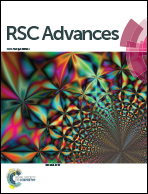A polymer/clay nanocomposite gel via chlorinated paraffin solvent initiated photopolymerization with electrorheological performance†
Abstract
This communication reports a mild preparation of a polymer/clay nanocomposite gel of chlorinated paraffin with an electrorheological response to an external direct-current (DC) voltage due to the alignment of the clay within the gel networks.


 Please wait while we load your content...
Please wait while we load your content...